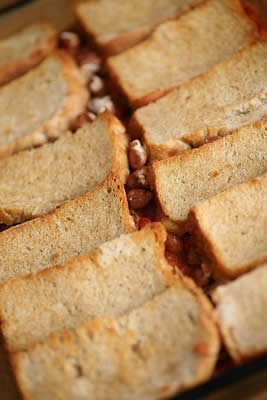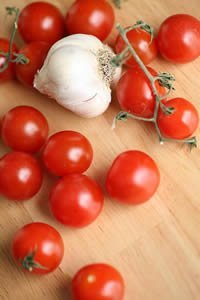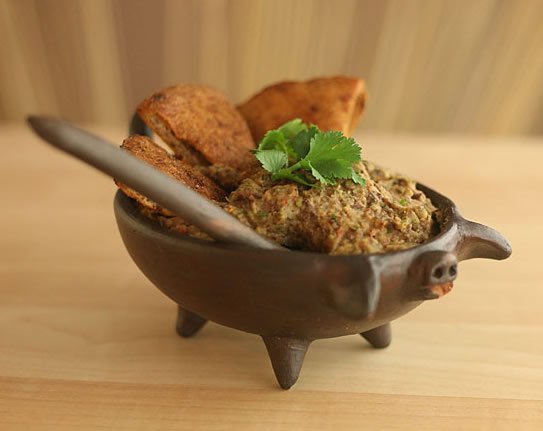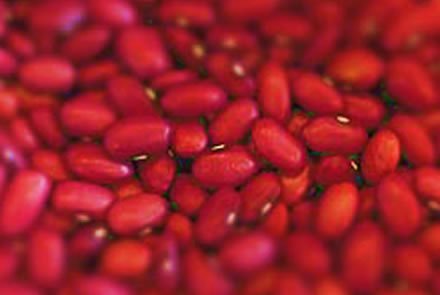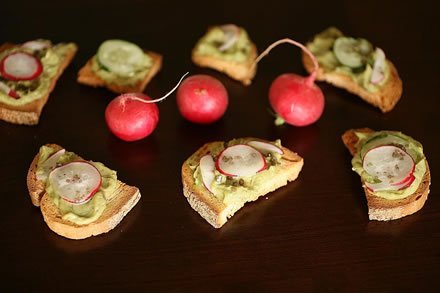
(Vegetarian, vegan, gluten-free option)
A funny thing happened on the way to the French loaf.
I’ll admit that sometimes, I find myself so enamored of a dish that I’m tempted to toss in a handful of beans, just so that it qualifies as a bean blog post. Problem is, superfluous beans often give themselves away. It can work out, as with the Baked Tomatoes with Crusty Bread. Then again, it can go terribly wrong, as with the white bean and pumpkin risotto. Yeah, I know, what was I thinking? It doesn’t even sound good. Needless to say, that recipe never made it here.
With this week’s recipe though, the beans absolutely transformed what otherwise might have been another version of guacamole. But first things first.
Recently I discovered smoked salt. It must be old news in the culinary world, but it’s new to me. I was wandering the sample circuit at Whole Foods and absentmindedly accepted a granule of the Na. I was blown away.
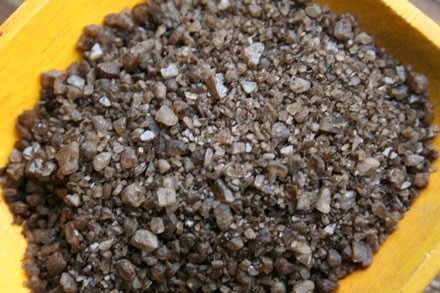
The flavor is intense – biting, meaty, and lingering – and the aroma conjures images of great forest fires. As with most large-granule colored salts, it’s often meant as a finishing salt, adding a heftiness to a dish.
Inspired by spring and the not-long-passed St. Patty’s Day, I was aiming for green. Put in a mood by rapidly and perpetually fluctuating weather extremes, I was also going for polemic flavors that would smooth and balance one another. I hit upon an avocado spread.
The Recipe
My thinking was that the smoky salt would sharpen the creaminess of the avocado. A spike of lemon served a dual function, waking up the spread and also preventing it from browning. I envisioned it atop crostini, garnished with thin slices of radish and cucumber. And so it turned out, a delightfully fresh, spring-green hor deourve full of punch. I was chuffed.
But oh. The beans.
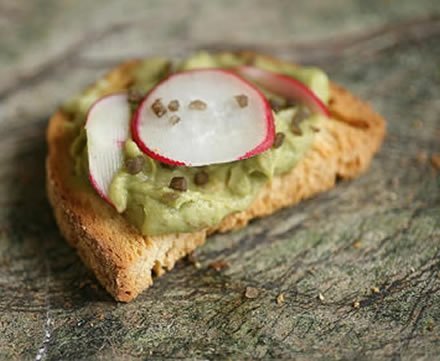
It was with reluctance that I acknowledged that I had to throw some into the food processor if this recipe would qualify for the bean blog. Admittedly, I didn’t use a lot of beans, proportionally speaking. Since there are few, and since they get blended to an unrecognizable finish, this is one case where I’d probably recommend against using an heirloom. My rules are my rules though, so I went with an old heirloom called Elvie.
Grown out from a seed obtained from Baker Creek Heirloom Seeds, these beans are creamy white-beige in color. According to Jere Gettle of Baker Creek, the seed was originally given to him by a customer, who claimed that it had been (and still is) grown in his family for generations. Gettle describes them as having an “old time flavor”. I don’t know exactly what that means when it comes to beans, but they are creamy, rich, moist and not too meaty.
Whatever their characteristics, they worked a magic on the avocado spread. Where it had a thin, runny consistency B.E(lvie)., the legumes gave it a silken, smooth, full-bodied and whipped texture. Where it had been like salsa (in texture only), it was now like mayonnaise, decadent and soft.
I used a bit of smoked salt in the puree, and also as a finisher. But know this: smoked salt speaks loudly and carries a big stick. A pinch will get you where you need to go.
Another thought: lovely as a dip or spread, the puree would make a lovely addition to scrambled eggs or huevos rancheros. But my guess is that it won’t last long enough to find a second use.
Avocado Spread with Smoked Salt and Elvie Beans
3 ripe avocados
One large lemon, cut in half
1 teaspoon smoked salt
½ cup cooked Elvie beans
Radish and cucumber, sliced very thinly for garnish
½ loaf of rustic French bread
Preheat the oven to 350. Slice the French bread into rounds, and then halve those pieces. Place on baking sheet and toast until golden, about 10 minutes, turning once during baking time. If you wish, you can brush olive oil onto the bread slices before baking.
Peel avocados and place them in food processor, along with the juice of half the lemon, the smoked salt and the Elvies. Process until the ingredients have formed a rich spread with a silken texture. You may want to add a bit more lemon juice and/or salt – modify it to your taste.
Spread avocado puree onto the crostini and line them up on a tray. Taking the other half of the lemon, spritz the crostinis with the remaining lemon juice.
Using a peeler, shave very thin slices of avocado and cucumber. Alternating between radish and cucumber, place one or two slices on top each hor deourve, then finish with a granule or two of smoked salt. Enjoy!




